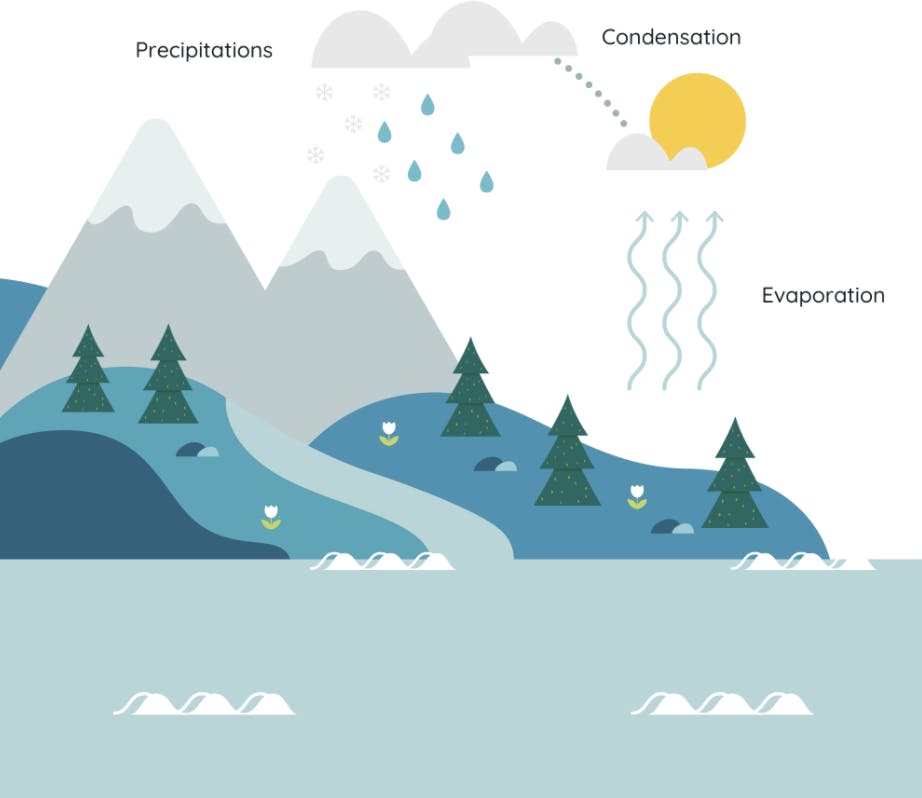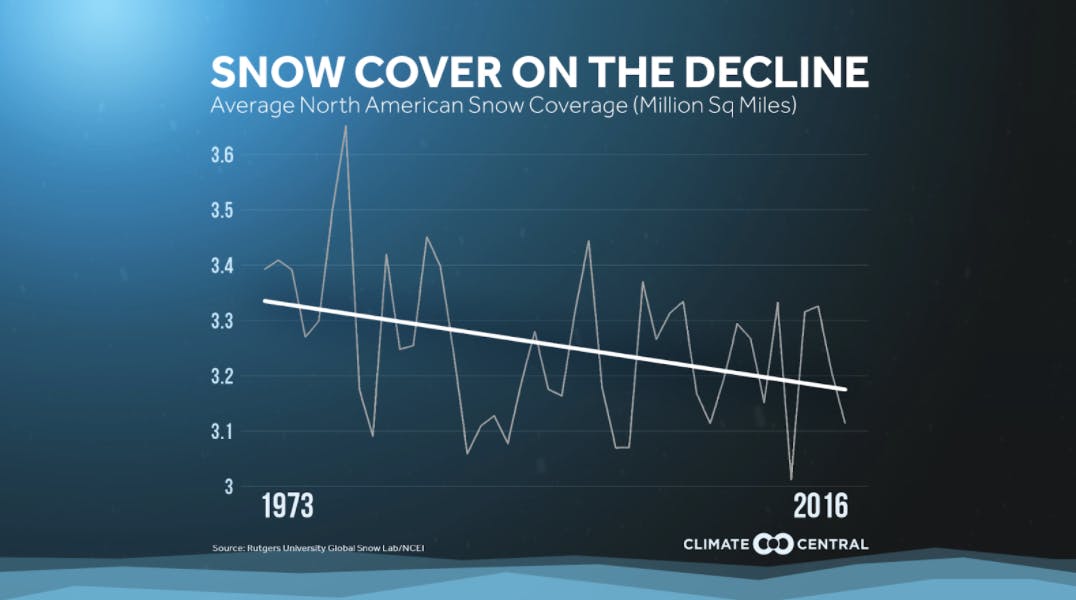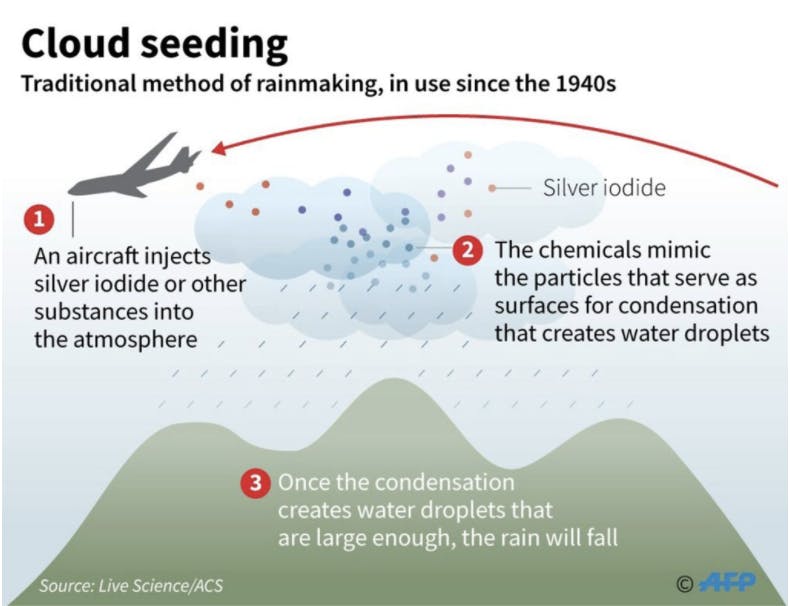TL;DR Science: Cloud Seeding: Producing Snow Manually
By Aya Khalaf
March 09, 2022 · 5 minute read
Environmental Science
Earth Science
We all took those geography classes, back in middle school mainly, where we studied how snow forms and how temperature isn’t the only factor that contributes to this phenomenon taking place.
Now let me give you a small refresher about that one geography lesson about how snow forms. First, water in oceans and lakes evaporates and turns into vapor which rises into the atmosphere reaching clouds of low temperature. When the steam and the cloud get in contact, the steam condenses to droplets. These droplets then gather around microscopic particles - like sand and dust - inside the clouds. Next, precipitation takes place, this process depends on how low the temperature gets. Once the temperature of the cloud reaches a freezing point - which is 0℃ or less - the water inside them freezes and transforms into snowflakes - due to coldness and steam inside the clouds. Lastly, these cold little ice crystals will increase in size and weight causing them to become heavy therefore falling off the clouds as snow.

Why is snow essential and good for the environment?
Snow plays a huge role in stabilizing and protecting the climate of our planet. The snow cover - areas of landscapes in which the snow covers - holds a very advantageous role on the soil, especially for plants. In other words, once the snow melts, it provides water which is the runoff of the melted ice. This can hydrate plants and improve the agricultural field.
Besides the fact that Earth today suffers from a growing drought that is slowly killing life off every green land, snow reflects about 80 to 90% of the sun’s energy back into the atmosphere allowing it to help regulate the exchange of heat between the Earth’s surface and the atmosphere, thereby cooling the planet.
In addition, as ironic as what I’m about to share with you may seem, snow cover works as an insulating blanket which can heat the ground covered with snow and prevent ground moisture from leaving and evaporating into the atmosphere.
The snow dilemma taking place due to today’s circumstances
As generous as Mother Nature has been because of all that she has offered from unconditional rain and snow to unlimited sun rays and warmth, one cannot guarantee that such phenomena can last as long as forever. Nonetheless, the longer man is existent, the more problems he causes from pollution to climate change.

Snow and climate have an equivalent reversible relation where they both affect each other. To go more in depth, climate changes lately have been seemingly affecting the flow of snow and its annual rates. Overall, warmer temperatures are shortening the amount of time snow is on the ground in the Northern Hemisphere. Recent temperature increases in the Arctic have also led to decreased snow and ice cover in many areas during parts of the year. Furthermore, they’ve also led to earlier melting of snow cover, which is changing when and how much water is available in some rivers and reservoirs as well as lengthening the growing season.
Because changes in snow cover can severely impact Earth’s environment and ecosystems as well as people’s access to water resources, scientists continuously measure how much of the planet is covered by snow. In the long term, this record will help scientists understand how snow cover and Earth’s climate are changing, and in the short-term, it can help water resources managers assess and plan for each spring’s snowmelt.
Cloud seeding and its inventor
Many scientists, especially chemists, tried working on finding resolutions. However, only one individual was able to discover and invent something so remarkably advantageous and environmentally friendly.
Vincent Schaefer, a self-taught chemist, invented cloud seeding and created the first artificially induced snow and rainfall. In short, Schaefer drew worldwide attention with his 1946 experiments for General Electric Co. making the first snowstorm in a laboratory and inducing precipitation outdoors, solving many of the mysteries of rain and snow that had baffled scientists.
This astronomical invention raised hopes in fighting drought, perhaps climate change too, controlling storms - especially in airport areas - and ensuring a completely white Christmas.
Cloud seeding is a weather modification technique that improves a cloud’s ability to produce rain or snow by artificially adding condensation nuclei (ice crystals that form when water vapor in the atmosphere cools and condenses around a particle of dust or salt) to the atmosphere, providing a base for snowflakes or raindrops to form. After cloud seeding takes place, precipitation falls from the clouds back to the surface of the Earth.
You may be wondering how this modification may take place. Here is how cloud seeding is done: specialists and experts first use an aircraft or drones to add small particles of silver iodide (which have a structure similar to ice) to clouds. Water droplets then cluster around the particles, modifying the structure of the clouds and increasing the chance of precipitation.

“With drought still a major concern, cloud seeding is an encouraged technology for Wyoming to use based on our drought contingency plan,” said Julie Gondzar, project manager for the United States’ water development office. “It is an inexpensive way to help add water to our basins, in small, incremental amounts over long periods of time.”
TL;DR
This climate modification project can work wonders and really open new horizons and possibilities for further evolution, whether environmental or technological. Cloud seeding is the biggest evidence that humans are smart and capable enough to create, invent and have the resources surrounding them wrapped right around their fingers.
Sources
https://www.oceanclock.com/en/blog/40-how-does-snow-form
https://www.ncdc.noaa.gov/news/picture-climate-what%E2%80%99s-snow-cover-got-do-it
https://www.chicagotribune.com/news/ct-xpm-1993-07-29-9307290226-story.html
https://www.theguardian.com/environment/2021/mar/23/us-stated-cloud-seeding-weather-modification
Did you enjoy this article?
About The Author
Aya is a high school rising-senior. She is a huge bookworm, spends too much money on books and is basically a school nerd. Contact her at aya@sciteens.org for article suggestions and book recommendations.